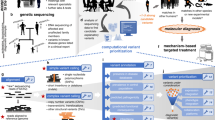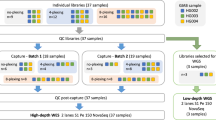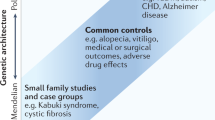Abstract
Recent advances in next-generation sequencing (NGS) make it possible to directly sequence genomes and exomes of individuals with Mendelian diseases and screen sequence data for causal variants. With the reduction in cost of NGS, DNA samples from entire families can be sequenced and linkage analysis can be performed directly using NGS data. Inspired by ‘burden’ tests, which are used for complex trait rare variant association studies, we developed the collapsed haplotype pattern (CHP) method for linkage analysis. Using data from several deafness genes we demonstrate that the CHP method is substantially more powerful than analyzing individual variants. Unlike applying NGS data filtering approaches, the CHP method provides statistical evidence of a gene’s involvement in disease etiology and is also less likely to exclude causal variants in the presence of phenocopies and/or reduced penetrance. The CHP method was implemented in the SEQLinkage software package, which can perform linkage analysis on NGS data or can generate data compatible with many linkage analysis programs, reviving them for use in NGS era.
Similar content being viewed by others
Log in or create a free account to read this content
Gain free access to this article, as well as selected content from this journal and more on nature.com
or
References
Ng SB, Buckingham KJ, Lee C et al: Exome sequencing identifies the cause of a mendelian disorder. Nat Genet 2010; 42: 30–35.
Santos-Cortez RLP, Lee K, Azeem Z et al: Mutations in KARS, encoding lysyl-tRNA synthetase, cause autosomal-recessive nonsyndromic hearing impairment DFNB89. Am J Hum Genet 2013; 93: 132–140.
Smith KR, Bromhead CJ, Hildebrand MS et al: Reducing the exome search space for Mendelian diseases using genetic linkage analysis of exome genotypes. Genome Biol 2011; 12: R85.
Huang Q, Shete S, Amos CI : Ignoring linkage disequilibrium among tightly linked markers induces false-positive evidence of linkage for affected sib pair analysis. Am J Hum Genet 2004; 75: 1106–1112.
Abecasis GR, Wigginton JE : Handling marker-marker linkage disequilibrium: pedigree analysis with clustered markers. Am J Hum Genet 2005; 77: 754–767.
Li B, Leal SM : Methods for detecting associations with rare variants for common diseases: application to analysis of sequence data. Am J Hum Genet 2008; 83: 311–321.
Karlis D : An EM algorithm for multivariate Poisson distribution and related models. J Appl Stat 2003; 30: 63–77.
Cottingham RW Jr, Idury RM, Schäffer AA : Faster sequential genetic linkage computations. Am J Hum Genet 1993; 53: 252–263.
Lathrop GM, Lalouel JM, Julier C, Ott J : Strategies for multilocus linkage analysis in humans. Proc Natl Acad Sci 1984; 81: 3443–3446.
Abecasis GR, Cherny SS, Cookson WO, Cardon LR : Merlin—rapid analysis of dense genetic maps using sparse gene flow trees. Nat Genet 2002; 30: 97–101.
Mukhopadhyay N, Almasy L, Schroeder M, Mulvihill WP, Weeks DE : Mega2: data-handling for facilitating genetic linkage and association analyses. Bioinformatics 2005; 21: 2556–2557.
Kruglyak L, Daly MJ, Reeve-Daly MP, Lander ES : Parametric and nonparametric linkage analysis: a unified multipoint approach. Am J Hum Genet 1996; 58: 1347–1363.
Lander E, Kruglyak L : Genetic dissection of complex traits: guidelines for interpreting and reporting linkage results. Nat Genet 1995; 11: 241–247.
Freimer NB, Sandkuijl LA : Blower SM. Incorrect specification of marker allele frequencies: effects on linkage analysis. Am J Hum Genet 1993; 52: 1102–1110.
Huang Q, Shete S, Swartz M, Amos CI : Examining the effect of linkage disequilibrium on multipoint linkage analysis. BMC Genet 2005; 6: S83.
Li B, Leal SM : Ignoring intermarker linkage disequilibrium induces false-positive evidence of linkage for consanguineous pedigrees when genotype data is missing for any pedigree member. Hum Hered 2008; 65: 199–208.
Fishelson M, Geiger D : Exact genetic linkage computations for general pedigrees. Bioinformatics 2002; 18 (Suppl 1): S189–S198.
O’Connell JR, Weeks DE : The VITESSE algorithm for rapid exact multilocus linkage analysis via genotype set-recoding and fuzzy inheritance. Nat Genet 1995; 11: 402–408.
Acknowledgements
The authors would like to thank Regie Lyn Santos-Cortez, Daniel Weeks, Alejandro Schaffer, Jeffrey O’Connell and Jurg Ott for helpful discussions and support. This work is funded by National Institute of Health (DC003594, DC011651 and HG006493). Web Resources: America's Families and Living Arrangements, https://www.census.gov/prod/2013pubs/p20-570.pdf. Exome Variant Server, http://evs.gs.washington.edu/EVS. DVD, http://deafnessvariationdatabase.com. NCBI ClinVar, https://www.ncbi.nlm.nih.gov/clinvar. Hapmap Recombination Rates and Hotspots database, http://hapmap.ncbi.nlm.nih.gov/downloads/recombination/latest/rates/.
Author information
Authors and Affiliations
Corresponding author
Ethics declarations
Competing interests
The authors declare no conflict of interest.
Additional information
Supplementary Information accompanies this paper on European Journal of Human Genetics website
Supplementary information
Rights and permissions
About this article
Cite this article
Wang, G., Zhang, D., Li, B. et al. Collapsed haplotype pattern method for linkage analysis of next-generation sequence data. Eur J Hum Genet 23, 1739–1743 (2015). https://doi.org/10.1038/ejhg.2015.64
Received:
Revised:
Accepted:
Published:
Issue date:
DOI: https://doi.org/10.1038/ejhg.2015.64
This article is cited by
-
Identification of autosomal recessive nonsyndromic hearing impairment genes through the study of consanguineous and non-consanguineous families: past, present, and future
Human Genetics (2022)
-
A quantitative trait rare variant nonparametric linkage method with application to age-at-onset of Alzheimer’s disease
European Journal of Human Genetics (2020)
-
A powerful new method for rare-variant analysis of quantitative traits in families
European Journal of Human Genetics (2020)
-
Exome genotyping and linkage analysis identifies two novel linked regions and replicates two others for myopia in Ashkenazi Jewish families
BMC Medical Genetics (2019)
-
Small posterior fossa in Chiari I malformation affected families is significantly linked to 1q43-44 and 12q23-24.11 using whole exome sequencing
European Journal of Human Genetics (2019)



